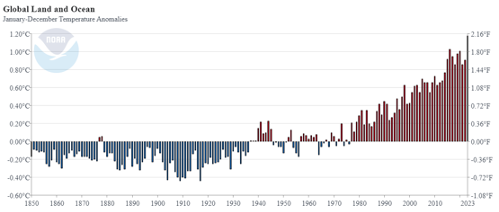The year 2023 was notable for setting several historic records. Greenhouse gas levels, global temperatures, sea level rise, and Antarctic sea ice melt have all reached unprecedented levels. It was the warmest year since global records began in 1850, with a temperature 1.18°C above the 20th-century average. Drastic changes in weather patterns, enhanced by global warming, have caused significant impacts on the environment, society, and the economy worldwide.
2023 recorded a global average temperature of 14.98°C, which is 0.17°C higher than the previous highest annual value in 2016. It is 0.60°C above the average of the last century and 1.48°C above the pre-industrial level of 1850-1900. Each month from June to December 2023 was warmer than any corresponding month in previous years, with July and August as the two months with the highest records.

As we can see in the picture, high-temperature anomalies have increased significantly since the early 1980s. Since 2020, these anomalies have moved closer and closer to 1°C, exceeding the gap in 2023. For the first time on record, every day in year 23, they exceeded one °C above the pre-industrial level for that time of year. Nearly 50% of days were warmer than 1.5°C, and two days in November were above two °C for the first time.
Ocean temperatures also experienced a significant increase. 2023 was the first year global average ocean surface temperatures exceeded one °C compared to pre-industrial levels. As discussed in previous notes, rising ocean surface temperatures lead to lower CO2 uptake and loss of marine wildlife, which decreases fisheries and related employment and puts pressure on seafood prices.
During 2023, global extreme weather events such as floods, wildfires, droughts, and heat waves severely affected health, ecosystems, nature and infrastructure. Climate change exacerbated the potency of these. Floods associated with extreme rainfall from the Mediterranean Cyclone Daniel, Hurricane Otis in Mexico, Tropical Cyclone Freddy in Africa and Cyclone Mocha in the Bay of Bengal had devastating consequences, destroying cities and crops and causing human loss and displacement.
Forest fires in Canada broke records with 18.5 million hectares burned, six times the 10-year average. In Chile, fires consumed almost half a million hectares in the centre and south of the country, just over 6,000 of which were crops. Hawaii suffered the deadliest fire of the year, with at least 99 deaths. Five years of drought and flooding caused human displacement in the Horn of Africa. The drought reduced the soil's capacity to absorb water, increasing the risk of flooding during the rainy season in April and May.
In the case of Central and South America, prolonged drought caused crop losses and water shortages. In Argentina, soybean and wheat production fell by 54% and 48%, respectively. In August, agricultural activity declined by 27.1%, while exports of primary products fell by 35.7%. In Uruguay, drought affected the whole country due to salinity in Montevideo's drinking water system resulting from recycled seawater. The Ministry of Livestock, Agriculture and Fisheries (MGAP) reported historic losses of US$1,809 million in agriculture.
In Brazil, 16% of the territory faces desertification, affecting 31 million people. The drought in the Amazon, which began in mid-2023, increased the number of fires and led to agricultural losses and water and food shortages. Rivers reached record lows, and the heat killed thousands of fish, including 150 pink dolphins. Experts argue that the drought may extend until June 2024.
The Global Carbon Project estimates that global carbon dioxide emissions will exceed 40 billion tonnes in 2023, with about 37 billion tonnes coming from fossil fuels. Overall, emissions increased by 1.1% compared to 2022 levels. If current CO2 emissions persist, the existing carbon budget available for a 50% chance to limit warming to 1.5 °C will only last seven years. As long as emissions continue unabated, the weather events we saw in 2023 will become the new normal. These events exacerbate food security problems, increased weather migrants and impacts on vulnerable groups.










